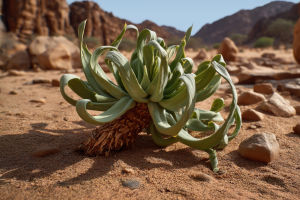Root Power Uncovered
Have you ever thought about how a plant drinks or eats? It may not have a mouth, but it certainly takes in everything it needs—from deep underground!
The secret lies in its roots. In this article, we'll dig into the science behind how roots absorb water and nutrients. You'll discover just how complex and efficient this hidden part of a plant truly is.
Roots: More Than Just Anchors
Roots do far more than keep a plant standing upright. They are living organs responsible for absorbing water, gathering essential nutrients, storing energy, and even communicating with soil microbes. They're busy, dynamic systems operating just below the surface.
The two main types of roots are:
• Taproots: One thick main root (like in carrots).
• Fibrous roots: A dense network of thin roots (like in grasses).
Both types perform similar functions but in slightly different ways depending on the plant's environment and growth needs.
The Journey Begins: Water Absorption
Water absorption starts at the very tips of young roots. These tips are covered in root hairs—tiny extensions of root cells that greatly increase surface area. Think of them like super-fine straws poking through the soil. The process of water entering the root is mostly passive, relying on osmosis.
Osmosis is the movement of water from an area of low solute concentration (in the soil) to high solute concentration (inside root cells) across a semi-permeable membrane. This keeps water flowing naturally into the root without requiring energy from the plant.
Water's Path Through the Root
Once water enters the root hair cells, it travels inward through one of three pathways:
• Apoplast pathway: Water moves through the cell walls.
• Symplast pathway: Water moves from cell to cell through plasmodesmata (tiny channels).
• Transmembrane pathway: Water crosses cell membranes repeatedly.
Eventually, water reaches the xylem, the plant's internal water highway. The xylem carries water upward, defying gravity, all the way to leaves and flowers. This upward movement is driven by transpiration—the evaporation of water from leaf surfaces—which pulls water like a chain up through the plant.
How Roots Absorb Nutrients
In addition to water, plants need minerals and nutrients like nitrogen, phosphorus, potassium, calcium, magnesium, and iron. These nutrients exist in the soil as ions—charged particles that roots absorb in two main ways:
1. Passive uptake: Some nutrients enter root cells along with water during osmosis or diffusion.
2. Active transport: Other nutrients require the plant to use energy (ATP) to pump ions into root cells against their concentration gradient.
Each nutrient plays a unique role:
• Nitrogen helps with leaf and stem growth.
• Phosphorus supports energy transfer and root development.
• Potassium regulates water balance and enzyme activity.
The Role of Root Hairs
Root hairs are critical to the absorption process. These tiny structures can number in the thousands on a single root, and they:
• Increase the surface area for absorption by up to 20 times.
• Grow only in the zone of maturation, just behind the root tip.
• Live only for a few days, constantly being replaced.
Without root hairs, a plant would struggle to absorb enough water or nutrients to survive.
Helping Hands from Soil Microbes
Roots don't work alone. They form symbiotic relationships with soil organisms that enhance absorption:
• Mycorrhizal fungi grow into or around roots, helping absorb phosphorus and other nutrients in exchange for sugars.
• Nitrogen-fixing bacteria, especially in legumes, convert nitrogen from the air into a form roots can absorb.
These underground partnerships create a rhizosphere, a busy ecosystem around the root zone that supports healthy plant growth.
How Soil Affects Root Absorption
Soil quality plays a major role in how effectively roots absorb water and nutrients. Key factors include:
• Soil texture: Sandy soils drain too quickly; clay holds too much water. Loamy soil is ideal.
• pH levels: Most nutrients are available at a pH of 6–7. Too acidic or alkaline, and nutrient uptake drops.
• Compaction: Tightly packed soil prevents root growth and reduces oxygen availability.
Gardeners and farmers test and amend their soil regularly to ensure optimal root function.
How Plants Adapt to Harsh Conditions
Plants in tough environments have developed clever root adaptations:
• Desert plants grow deep taproots to find water.
• Rainforest plants have shallow roots to absorb surface nutrients.
• Mangroves use aerial roots to breathe in oxygen from air instead of soggy soil.
These adaptations prove that roots are not one-size-fits-all—they evolve with the needs of the plant.
What Happens When Roots Don't Work Properly?
If roots are damaged or can't absorb well, the whole plant suffers. Signs include:
• Wilting, even when soil is wet
• Yellowing leaves from nutrient deficiency
• Stunted growth
Common causes of poor absorption include overwatering, root rot, soil pests, and nutrient imbalance. Knowing how roots function can help you diagnose and fix plant health problems.
What Can You Do to Support Healthy Roots?
Whether you're growing houseplants, vegetables, or trees, you can help their roots thrive by:
• Using well-draining soil and containers
• Avoiding overwatering or underwatering
• Fertilizing with the right balance of nutrients
• Repotting when plants outgrow their containers
• Adding organic matter to garden soil for structure and nutrients
Healthy roots mean a strong, vibrant plant above ground.
The Hidden Heroes Beneath Our Feet
Roots are one of the most overlooked yet essential parts of plant life. Every drop of water and every grain of nutrient a plant absorbs comes through its roots first. They're powerful, efficient, and full of smart systems that keep the plant alive and thriving.
Next time you admire a flower, tree, or houseplant, take a moment to appreciate what's going on underground. Would you like to learn how to boost root health in your garden? Or try a root-viewing experiment at home? Let's explore the soil together—there's a whole world waiting below!
-
 Plant Breathing BasicsWhat Is Plant Respiration? Discover the Hidden Process That Keeps Plants Alive Day and Night
Plant Breathing BasicsWhat Is Plant Respiration? Discover the Hidden Process That Keeps Plants Alive Day and Night -
 Rocky Desert SurvivorGet Up Close with the 2,000-Year-Old Plant Thriving in Harsh Rocky Deserts!
Rocky Desert SurvivorGet Up Close with the 2,000-Year-Old Plant Thriving in Harsh Rocky Deserts! -
 Blue Orchid BlissUnveil the Stunning Blue Orchid That Fills Your Home with Rare Beauty, Elegant Blooms, and Irresistible Fragrance!
Blue Orchid BlissUnveil the Stunning Blue Orchid That Fills Your Home with Rare Beauty, Elegant Blooms, and Irresistible Fragrance!
Copyright © zogu 2021 - 2025. All Right Reserved.